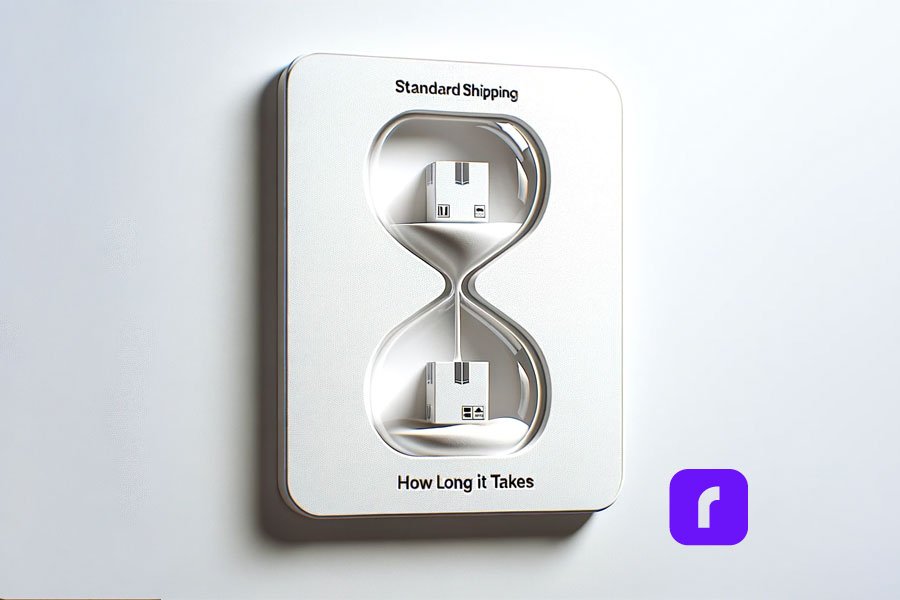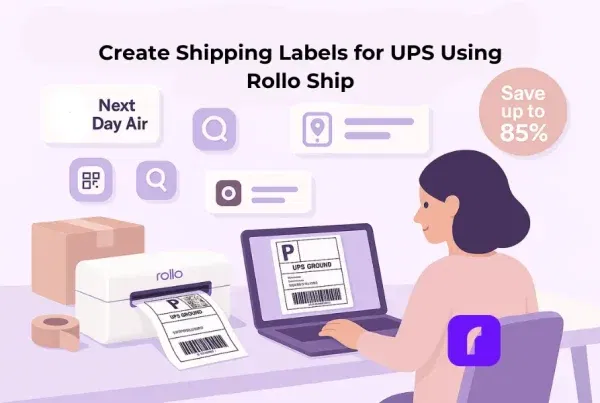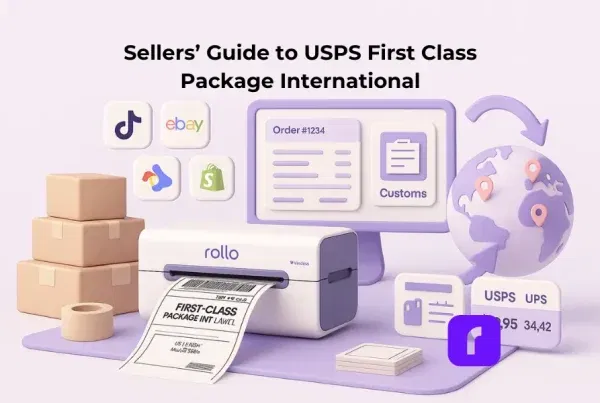In the ever-evolving world of e-commerce, it is crucial to comprehend various shipping options. For both sellers and buyers, understanding the intricacies of these options is paramount. Standard shipping is important for transporting goods over long distances in the logistics industry. This guide covers the basics of standard shipments. It includes information on how long it takes, how much it costs, and which major carriers offer it. Some of the major carriers that offer it are UPS, USPS, and FedEx.
Table of Contents

Defining What is Standard Shipping
Standard shipping, commonly known as regular or ground shipping, is often the default and most economical option provided by carriers. In contrast to express or overnight shipping, the standard one typically utilizes ground transportation. This makes it a cost-effective solution for deliveries that are not time-sensitive.
Balancing between speed and affordability, regular shipping is a widely preferred choice for a plethora of e-commerce activities. It caters well to standard delivery needs, providing a reliable yet budget-friendly option for transporting goods.
Assessing Standard Shipping Duration
The length of ground shipping time depends on factors like distance, carrier choice, and shipping route details.
📌 How Long Does Usually It Take for Standard Shipping?
Typically, it takes within the United States ranges from 2 to 8 business days. For example, USPS’s ground shipping, known as USPS Ground Advantage, promises delivery within 2-5 business days. Similarly, services like UPS Ground and FedEx Ground generally take about 1-5 business days. These delivery times make this type of shipping a viable option for both personal and business shipments that do not require expedited service.

Tracking and Transparency
Most standard services offer tracking capabilities, providing visibility for both the sender and the recipient. Standard shipping tracking provides transparency and reassurance, helping customers know when their orders will arrive and plan accordingly. It not only enhances customer experience but also builds trust in the shipping process.
Understanding the Averages
The typical form of standard shipping involves the movement of parcels via ground services. Transit times and costs differ based on the carrier and where the package is going. Particularly favored for shipments that aren’t urgent but demand reliable delivery, this method is used.
Standard shipping usually moves packages by trucks or trains, affecting delivery times and costs.
Transit Times and Costs
The average transit times for standard shipping can vary significantly based on the carrier and the distance to the final destination. For instance:
- Within Regional Areas: Shipments within closer geographical areas usually reach their destination faster, often within 1-3 business days.
- Cross-Country Shipments: For packages traveling across the country, the delivery can take longer, usually between 4-8 business days.
The cost associated with standard shipping also varies. The cost of shipping depends on the parcel’s weight, size, distance, and the carrier’s pricing policies. Generally, standard shipping is a more cost-effective option compared to expedited shipping services.
Reliability and Suitability
Standard shipping is favored for its reliability. Although it may not be the fastest, this service is reliable and predictable. This is crucial for businesses that need to organize their logistics and inventory. It is also beneficial for individuals who are planning purchases and deliveries.
Standard Shipping for Non-Urgent Deliveries
This type of shipping is particularly suitable for non-urgent deliveries. It is commonly used for online shopping, small business orders, and personal shipments like gifts. It is not for urgent delivery but still arrives within a reasonable time frame.
The Role of Major Carriers
Major carriers like USPS, UPS, and FedEx offer standardized ground shipping options that cater to a wide range of shipping needs:
- USPS: Known for its extensive reach and affordability, especially for smaller parcels.
- UPS: Offers a balance between speed and cost, often used for slightly larger shipments.
- FedEx: Renowned for its reliable tracking system and efficient ground shipping services.
Deciphering What “Standard Shipping Only” Means
When a seller or carrier specifies “standard shipping only,” they refer to the most basic form of shipping available—typically ground shipping. This option excludes expedited services like FedEx Ground or next-day delivery, striking a balance between affordability and timely delivery. It’s an ideal choice for standard ecommerce transactions where cost efficiency is paramount, and immediate delivery isn’t a necessity.
Deciphering the phrase “standard shipping only” is crucial for understanding the shipping options available when making a purchase or planning a shipment. This specification by a seller or carrier points directly to the most basic, yet widely used form of shipping — typically ground shipping. Here’s a deeper look into what this entails:
Standard Shipping as the Default Option
When a seller indicates “standard shipping only,” they are essentially setting ground shipping as the default and perhaps the only shipping option for that particular transaction. This mode of shipping typically involves transporting goods via land-based vehicles like trucks or trains, which, while not the fastest means of transportation, offer a reliable and cost-effective way to move parcels.
Exclusion of Expedited Services
When the seller or carrier says “standard shipping only,” they are not offering faster shipping options. FedEx Ground and next-day air deliveries are not available for that shipment. This exclusion holds particular relevance in e-commerce settings where businesses typically present customers with various shipping options.
Standard Shipping in E-commerce
In the e-commerce landscape, “standard shipping only” aligns with the expectations of a significant portion of online shoppers. These are customers who plan their purchases ahead and are not in urgent need of the items they order. It allows e-commerce businesses to offer a cost-effective shipping solution, which can be a decisive factor for customers sensitive to shipping costs.

Exploring Standard Shipping Methods
Standard shipping predominantly involves ground transportation, utilizing trucks and occasionally trains. This method is widely preferred for its cost-effectiveness and expansive reach, ensuring accessibility even to more remote areas. Ground shipping thus becomes synonymous with standard shipping, embodying a practical solution for a range of shipping needs.
Courier Choices for Standard Shipping
Major couriers like UPS, USPS, and FedEx offer standard shipping options. Each of these couriers has tailored their standard shipping services to cater to a broad range of needs, balancing speed, cost, and coverage.
In the broader scope of courier services, standard shipping stands as a pivotal delivery option. It fits into a spectrum that ranges from class mail to standard international shipping, and even to expedited shipping for urgent deliveries. For customers seeking free shipping, standard options often emerge as the most feasible choice.
Standard Shipping Pros and Cons
Standard shipping is cheap and covers a wide range of packages, making it good for many different types of items. Standard shipping takes longer than expedited options like FedEx Ground or day delivery services. This can be a limitation for time-sensitive deliveries.
| ✅ Pros | ❌ Cons |
|---|---|
| 💰 Cost-Effective: Generally cheaper than expedited shipping options. | ⏲️ Slower Delivery: Not ideal for urgent shipments. |
| 📮 Wider Package Acceptance: Suitable for a variety of package sizes and weights. | 📍 Limited by Geography: Longer delivery times for remote areas. |
| 🗺️ Tracking Availability: Most standard shipping options come with tracking. |
Incorporating Rollo Ship
The Rollo Ship App is an essential tool for shipping for small business, offering versatile management of standard shipping. This app assists users in consolidating orders from various marketplaces, accessing more affordable shipping rates, and printing labels effortlessly, even without a Rollo printer. Its compatibility with major carriers like USPS, UPS, and FedEx makes it invaluable for simplifying shipping processes, particularly during the busy holiday season.
💯 Versatility and Efficiency with Rollo Ship
The Rollo Ship App is distinguished by its versatility. It helps manage shipping for people who handle many orders from different marketplaces, making it a convenient solution. With Rollo Ship, users can easily consolidate orders from platforms like Amazon, Etsy, Shopify, eBay, and many more. This consolidation is important for businesses that use many online platforms. It helps them work more efficiently and spend less time managing orders.
⬇️ Access to Discounted Shipping Rates
One of the standout features of the Rollo Ship App is its ability to provide users with access to discounted shipping rates. These discounts are significant and can save users a substantial amount of money on shipping.
This is particularly beneficial for small businesses and individual sellers who need to save every dollar. Rollo Ship provides smaller businesses with affordable shipping options from USPS, UPS, and FedEx. These options were previously exclusive to larger companies.
🏷️ Simplifying the Label Printing Process
Rollo Ship also simplifies another critical aspect of the shipping process: label printing. The app allows users to print shipping labels easily, and there’s no requirement to own a Rollo printer. This flexibility means users can print labels from any printer, making the process convenient and accessible. The ability to quickly and efficiently print labels streamlines the packaging process, speeding up order fulfillment.
📦 Compatibility with Major Carriers
The app’s compatibility with major carriers, including USPS, UPS, and FedEx, is a significant advantage. This compatibility ensures that users can select the most suitable and cost-effective shipping options for their needs, whether it’s for domestic standard shipping or international deliveries. Furthermore, the integration with these carriers means users can benefit from the reliability and wide reach these carriers provide.
📨 Streamlining High-Demand Shipping
During high-demand periods, such as the holiday season, the efficiency and effectiveness of a shipping strategy become even more critical. Rollo Ship is an invaluable tool during these times. Its ability to handle high volumes of orders, coupled with the savings on shipping costs and the ease of label printing, makes it an essential asset for businesses and individuals looking to optimize their shipping processes during busy periods.
Incorporating the Rollo Ship App into a standard shipping strategy offers a wealth of benefits. From accessing discounted rates and consolidating orders across various platforms to simplifying label printing and leveraging the strengths of major carriers, Rollo Ship enhances the efficiency and cost-effectiveness of shipping operations. For anyone looking to streamline their standard shipping processes, particularly in high-demand scenarios, Rollo Ship is an indispensable tool.
Free registration, no monthly subscriptions, and 200 shipping labels on Rollo
Standard Shipping with Major Carriers: UPS, USPS, and FedEx
When exploring who delivers standard shipping, major carriers like USPS, UPS, and FedEx stand out. Each offers unique benefits:
- UPS Ground Shipping: UPS offers reliable ground shipping with relatively fast delivery speeds, typically ranging from 1-5 business days. It’s a preferred choice for standard delivery that balances time and cost.
| Service | Delivery Timeframe | Rates | Coverage |
|---|---|---|---|
| UPS Ground | 1-5 business days | Starting at approximately $23.38 for a 5 lb package from NY to LA for example, without leveraging the discounts from Rollo Ship. | All 50 states and Puerto Rico |
- USPS Standard Shipping: Known for its cost-effective rates and extensive reach, including PO boxes and military addresses. USPS standard shipping is ideal for less time-sensitive mail and packages.
| Service | Delivery Timeframe | Rates | Coverage |
|---|---|---|---|
| USPS Ground Advantage | 2-5 business days | Around $20.50 for a 5 lb package from NY to LA for example, without leveraging the discounts from Rollo Ship. | All 50 states, PO boxes, U.S. military bases, territories, possessions, and Freely Associated States |
- FedEx Ground: Catering to both commercial and residential deliveries, FedEx Ground is recognized for its efficiency and tracking capabilities. It’s an excellent choice for standard shipping that requires precise tracking and faster ground shipping services.
| Service | Delivery Timeframe | Rates | Coverage |
|---|---|---|---|
| FedEx Ground (commercial) and FedEx Home Delivery (residential) | 1-5 business days | Approximately $22.46 for a 5 lb package from NY to LA for example, without leveraging the discounts from Rollo Ship. | Commercial and residential addresses in all 50 states |
Plan Holiday Season: Tips for eCommerce Sellers and Gift Buyers
The holiday season is a critical period for both e-commerce sellers and gift buyers. Planning and understanding standard shipping deadlines are key to ensuring timely deliveries. Here are some tips to navigate this busy season effectively:
🕔 Understand Carrier Deadlines: Each carrier, including UPS, USPS, and FedEx, has specific cut-off dates for holiday shipping. Knowing these deadlines can help in planning shipments and informing customers.
🎀 Encourage Early Shopping: Advise customers to shop early to avoid the rush and potential delays common during the holiday season.
📦 Offer Multiple Shipping Options: While standard shipping is cost-effective, offering a range of options, including expedited services, caters to varied customer needs.
📢 Communicate Clearly: Keep your customers informed about expected shipping times and any potential delays. Transparency builds trust and reduces anxiety over order arrivals.
💲Leverage Shipping Discounts and Tools: Utilize tools like the Rollo Ship App, which offers integration with multiple carriers and platforms, along with significant discounts, to manage shipping efficiently.
Final Words
In conclusion, standard shipping remains a cornerstone of e-commerce logistics, particularly during the holiday season. To achieve smooth and affordable shipping, it is crucial to understand this type of shipping with major carriers. Additionally, utilizing tools such as Rollo Ship can be beneficial. Lastly, planning ahead is also essential. Remember, the key to successful holiday season shipping lies in early planning, clear communication, and choosing the right shipping partners and tools.
Follow Rollo on:
Frequently Asked Questions
📌 Q: Is Standard Shipping the Cheapest Option?
💭 A: Generally, standard shipping is among the cheapest options available, especially when compared to expedited or overnight shipping services. Its affordability makes it a go-to choice for regular e-commerce shipments.


